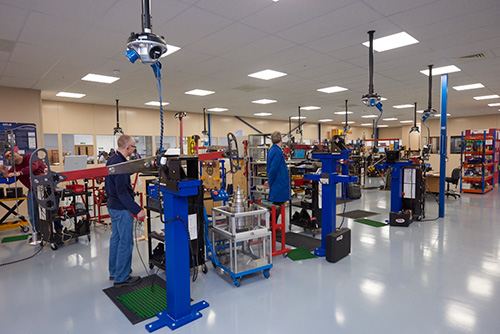 Norbar's Test Beams are designed for the static calibration of Torque Transducers. They are ideally suited to Norbar's transducers, but can be employed on other manufacturer's equipment.
Norbar's Test Beams are designed for the static calibration of Torque Transducers. They are ideally suited to Norbar's transducers, but can be employed on other manufacturer's equipment.
Torque is generated by the application of a known force at a known radius from the centre of rotation of the torque transducer.
Designed to remove potential sources of measurement error, these beams can be used to calibrate Norbar torque transducers, and torque transducers from other manufacturers (where design permits), as well as mechanical test devices. UKAS length certification is provided with each beam.
The Beams are designed with square drives machined to the top limit of ISO 2725:1987. This minimises any play between the beam and the transducer. However, a combination of square drive tolerances, misalignment of fittings and elastic rotation of the transducer shaft inevitably cause the beam to rotate from the horizontal under load.
Norbar's Radius Ended Beams are designed with a +/-8% degree usable arc within which the calibration accuracy is unaffected.
Additionally the beams are designed to apply load on a vertical plane which cuts through the square drive inside the transducer. This minimises bending moments on the transducer and, for safe operation, ensures that the beam will not fall out of the transducer.
Gravitational Effects
It is very important that the gravitational value for the Laboratory is established. The effect of not doing this could be a variation in the force produced by the weight of perhaps 0.5% of reading.
It is therefore stronly recommended that you establish the local value of gravity (g) for your Laboratory and use weights that have been calibrated at that gravitational constant.
The ideal solution is to have the gravity measured on site by the national geological survey agency.
The second best solution is to ask the national agency for a figure calculated from gravitational contour maps.
The third approach is to calculate the value from knowledge of the latitude, and height above sea level in metres. This will give an uncertainty of approximately +/-0.005% but will not reflect local differences due to rock structure etc. Norbar will perform this on request if the above information is provided.
Norbar will supply weights calibrated to gravitational constants specified by the customer. However, if the customer does not specify a value for 'g' they will have been calibrated at an estimated gravitational constant for the customers' location.
Buoyancy Effects
The Norbar system uses calibrated weights to generate a downwards force.
This means that Archimedes principle applies, ie. air pressure under the weights causes an upwards force. This reduces the effective force generated by the weights and therefore the mass must be increased to allow for this.
Under standard conditions (ie. Air density 1.2kg/m3 and 20 degrees centigrade and working in conventional mass terms) the increase required is by a factor of 0.015%.
Weights purchased from Norbar will already have this factor taken into account.
Weights that are calibrated to standard procedures do not have this factor taken into account because the air buoyancy affects both sides of the mass balance and can be ignored. It is important that weights used for torque transducer calibration are adjusted for air buoyancy.
It should also be noted that the double ended beam design employed by Norbar means that each half of the beam is balanced with regard to buoyancy of the beam. This is a significant advantage over single-arm counterbalanced systems.